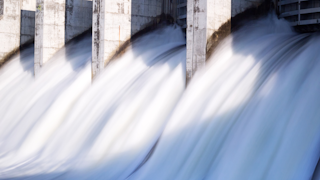Hydropower has played a key role in making Norway a leading energy producer. Hydropower has contributed to industrial development and economic growth. The legal framework governing hydropower production is based on the premise that Norway’s hydropower resources belong to, and shall be managed in the best interest of, the general public. This is reflected in, inter alia, a requirement for public ownership of major hydropower plants.
Norway is the seventh largest hydropower producer in the world, with more than 1,730 hydropower plants and 100 reservoirs. Norwegian hydropower production was about 140 TWh in 2021, which means that hydropower accounts for around 90 percent of overall national power production.
Norwegian hydropower offers numerous benefits. Hydropower is, first and foremost, a stable renewable energy source, since the water can be stored in reservoirs and used when needed. Norway has about half of Europe’s reservoir capacity, and more than 75 percent of Norwegian production capacity is storable. The scope for using storage hydropower in combination with other energy sources, such as sun and wind, improves flexibility in the power system.
Thommessen has assisted hydropower providers, large and small, for several decades, and we have extensive experience with all forms of legal issues in relation to hydropower. Thommessen has, inter alia, assisted on the establishment of Norway’s third largest hydropower provider; Lyse Kraft DA, and on the consolidation of the hydropower activities of Eidsiva and Hafslund E-CO, respectively.
The hydropower licensing process
Hydropower plant development will in the vast majority of cases require a licence under the hydropower development legislation.
Major hydropower developments require a licence under the Watercourse Regulation Act and/or the Water Resources Act. The King-in-Council is the licensing authority and makes the final administrative licence decision in these cases. The application is processed by the Norwegian Water Resources and Energy Directorate (NVE) in order to prepare a basis for such decision. There is no scope for administrative appeal when a licence is granted in major development cases, since the King-in-Council is the licensing authority.
Minor hydropower development (less than 10 MW) applications are processed by the NVE under the Water Resources Act. The decisions of the NVE may be appealed to the Ministry of Petroleum and Energy (OED), which makes the final administrative decision.
There are certain differences between the application processing of major and minor development applications under the hydropower legislation. Minor plant applications processed under the Water Resources Act are subject to somewhat simpler procedural rules than are major projects, thereby contributing to faster processing of such projects. The NVE has prepared a set of guidance notes on the various application processes.
In addition to a licence under the hydropower development legislation and a facility licence under the Energy Act for any electro-mechanical equipment, the owner of a hydropower plant may also, depending on the circumstances, need to obtain other decisions and permits under other legislation, as well as clarify how the project relates to municipal plans.
In addition to the requirement for 2/3 public ownership of major hydropower plants, a licence under the Waterfall Rights Act (formerly the Industrial Licensing Act) is also required to acquire any waterfall rights in excess of the licensing requirement threshold under the Act.
Transactions and reorganisations may trigger a licence requirement or a need for obtaining government consent for the assignment of licences or for the transfer of shares or other ownership interests in companies or partnerships which hold rights that are subject to licence.
Licence terms and conditions and the revision process
Hydropower licences include terms and conditions intended to alleviate and avert damage to, inter alia, the environment, nature and society. These conditions are a combination of standardised and more tailored conditions, and may pertain to various project phases (including, inter alia, the construction phase and the operating phase). Conditions relating to water release and minimum water flow are specific to hydropower licences. Specific water management provisions will be adopted for major developments.
Moreover, major hydropower plants will be subject to concessionary power and licence fee terms. These conditions require the owner of the hydropower plant to concede a portion of the power produced to the municipality (or municipalities) affected by the development (concessionary power) and to pay a specified fee (licence fee) to central government and to the municipality (or municipalities) affected by the hydropower plant.
Both the hydropower development legislation and the licences allow for revision of the licence terms and conditions after a certain period of time, and the Watercourse Regulation Act now includes a separate provision authorising the revision of all licences from 19 June 2022. The purpose of revision of the licence terms and conditions is, inter alia, to improve environmental conditions in the affected watercourses. However, the scope for revision only allows the authorities to revise the licence terms and conditions, and not the licence as such.
The public body seeking a revision of terms will often argue that the introduction of new, amended and/or burdensome terms and conditions is justified, including, inter alia, (new) minimum water flow requirements and amended manoeuvring provisions. Such terms and conditions may have production volume implications. Moreover, there may be costs associated with any implementation and follow-up of the said terms and conditions. Such demands must normally be balanced against other considerations, such as consideration for maintaining renewables production capacity, flood prevention and security of supply, and the introduction of such burdensome terms and conditions will thus not be justified as a matter of course. Private law matters are not subject to revision, and the same will normally apply to any financial terms that cannot be directly linked to the environmental terms.
Upgrading and expansion projects
The large-scale development of Norwegian hydropower production primarily took place from the 1950s to the 1980s, with the focus more recently having shifted, in part, to the need and scope for both upgrading and reinvestment. Upgrading initiatives are projects and interventions that do not necessitate the exploitation of more water or additional hydraulic head. Expansion projects, in contrast, involve refurbishing the power plant to exploit additional water or increasing hydraulic head. The advantage of upgrading and expansion projects is the potential for increasing hydropower production with a limited impact on the external environment. The NVE’s estimates suggest that mapped projects offer a total upgrading and expansion project potential of about 6-8 TWh. Such projects are often, against this background, highlighted as an alternative to further hydropower development.
Please do not hesitate to get in touch with us for more information on the legal framework governing hydropower in Norway.
Spotlight
Renewable energy projects towards 2030
Norway will need more renewable energy to succeed with the green shift and reach its target of reducing greenhouse gas emissions by 55 percent by 2030. We invite you to learn more about our role in making sure future renewable development projects are successful.
Read more



